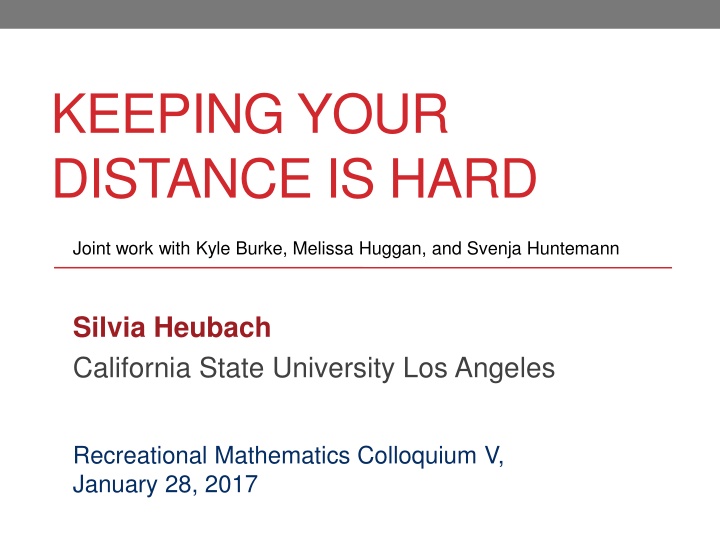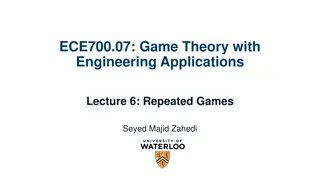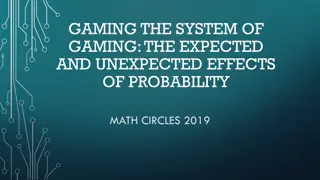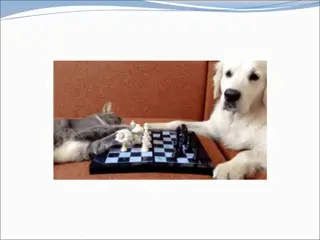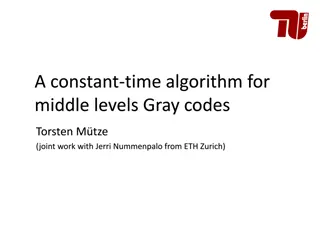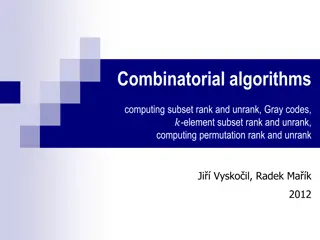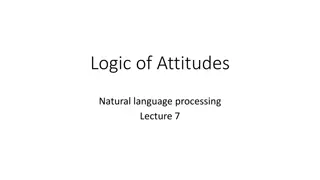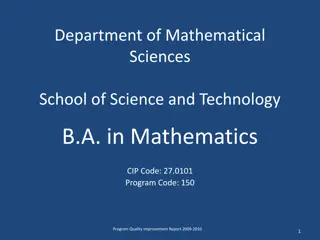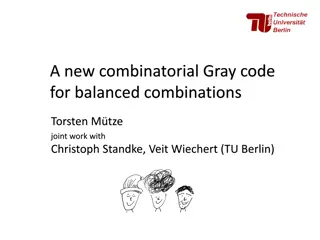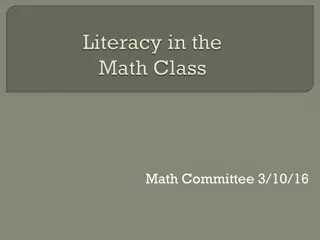Deciphering Combinatorial Games Through Mathematical Analysis
Discover the intricacies of combinatorial games by analyzing strategies for winning and understanding the dynamics of distance games on graphs. Learn about known distance games like COL, SNORT, and NODEKAYLES, and explore techniques such as strategy stealing and mirroring to determine optimal gameplay. Dive into the world of impartial games and recursive labeling of game graphs to unravel the mysteries of strategic gameplay.
Download Presentation

Please find below an Image/Link to download the presentation.
The content on the website is provided AS IS for your information and personal use only. It may not be sold, licensed, or shared on other websites without obtaining consent from the author.If you encounter any issues during the download, it is possible that the publisher has removed the file from their server.
You are allowed to download the files provided on this website for personal or commercial use, subject to the condition that they are used lawfully. All files are the property of their respective owners.
The content on the website is provided AS IS for your information and personal use only. It may not be sold, licensed, or shared on other websites without obtaining consent from the author.
E N D
Presentation Transcript
KEEPING YOUR DISTANCE IS HARD Joint work with Kyle Burke, Melissa Huggan, and Svenja Huntemann Silvia Heubach California State University Los Angeles Recreational Mathematics Colloquium V, January 28, 2017
The Basics A two-player game is called a combinatorial game if there is no randomness involved and all possible moves are known to each player. A combinatorial game is called impartial if both players have the same moves, and partizan otherwise. Examples: We consider the case where the last player to move wins (normal play).
Main Question: Who wins in a combinatorial game from a specific position? More specifically, do you want to be the first player, or the second?
Distance Games GRAPHDISTANCE(D,S) is the combinatorial game played on a graph G in which All vertices are uncolored at the beginning of the game. Two players, BLue (Left) and Red (Right) color uncolored vertices of the graph so that: A BLue vertex and a Red vertex are not allowed to have distance d if d D(Dis for different ) Two BLue vertices or two Red vertices are not allowed to have distance sif s S(Sis for same ) Vertices cannot change color or become uncolored.
Known Distance Games COL: adjacent vertices cannot have the same color COL= GRAPHDISTANCE( ,{1}) SNORT: adjacent vertices cannot have different colors. SNORT = GRAPHDISTANCE({1}, ) NODEKAYLES: adjacent vertices cannot bothbe colored. NODEKAYLES= GRAPHDISTANCE({1},{1})
Lets Play a Game (or two) Playing COL adjacent vertices cannot have SAME color Game is over Red wins! Playing SNORT adjacent vertices cannot have DIFFERENT color Blue Wins! Blue wins once more!
How Can We Analyze a Game? Strategy stealing, mirroring (3,1) COL (3,0) (2,1) Create a game graph and then recursively label positions as to who wins (1,1) (2,0) (1,0) (0,0)
Recursive Labeling of Game Graph For impartial games there are only two possibilities, N- and P- positions: Terminal positions are P- positions (losing) Any position that allows a move to a P-position is an N-position (wiNning) Any position for which all options are N- positions is a P-position. (3,1) N (3,0) N (2,1) N (1,1) (2,0) N P (1,0) N (0,0) P
Computational Complexity No symmetry or game tree too large? Use a computer program to label the positions of interest The amount of time (steps of the algorithm) and space (computer memory) needed for the computation is a measure of how hard it is to solve the game PSPACE-hard refers to a specific level of hardness
Complexity of Distance Games We know that COL, SNORT, NODEKAYLES played on graphs are PSPACE-hard We use these facts to show that GRAPHDISTANCE(D,S)is PSPACE-hard for general sets D and S. Process: If we know a game T is PSPACE-hard and want to show that another game Q is also PSPACE-hard, we need to find a mapping f, called a reduction, such that f maps the positions of T to the positions of Q fcan be computed in polynomial time f preserves winnability
Specifics of the Reduction The reduction transforms the graph G on which game T is played to a graph G on which Q is played via insertionof a subgraph called gadget G G Reduction f Game T Game Q
Play-by-Play Reduction A play-by play reduction is a reduction which satisfies these properties: Vertex Condition: None of the added vertices can be playable. No vertices of the original graph G will be deleted. Edge condition: Added edges will not introduce restrictions on the vertices of the original graph G. A play-by-play reduction is a bijection between games T and Q, so if T is a PSPACE-hard game, then so is Q, as the image of all possible graphs of T also need to be considered for Q.
Main Result THEOREM The games GRAPHDISTANCE(D,S) are PSPACE-hard when either S or D equals {1,2, ,n} and the other is a subset (or equal) to {1,2, ,n}. We will illustrate the proof with an example of a generalization of SNORT = GRAPHDISTANCE({1} , ) ENSNORT(n) := GRAPHDISTANCE({1,2, ,n} , )
Example for ENSNORT(3) Play SNORT D = {1}, S = Play ENSNORT(3) D = {1,2,3}, S = y y x x Reduction f z z
Forbidden vertex gadget ENSNORT(3) Play ENSNORT(3) D = {1,2,3}, S = x x x x y x Works also for S Dand max(S) < n
Proof of Main Result THEOREM The games GRAPHDISTANCE(D; S) are PSPACE-hard when either S or D equals {1,2, ,n} and the other is a subset(or equal) to {1,2, ,n}. Proof Outline: For GRAPHDISTANCE(D; S) with D= {1,2, ,n},S D,and max(S) < n,we reduce from SNORT S= {1,2, ,n},D S, and max(D) < n,we reduce from COL Sor D is{1,2, ,n}and max(D) = max(S),we reduce from NODEKAYLES
Why is case max(S) = max(D) different? Play SNORT D = {1}, S = Play GRAPHDISTANCE(D,S) D = {1,2,3}, S = {1,3} y y x x Reduction f We can color x and y in the same color in SNORT, but cannot in GRAPHDISTANCE(D,S), so winnability is no longer the same.
Reduction for max(S) = max(D) Play NODEKAYLES D = {1}, S = {1} Play GRAPHDISTANCE(D,S) D = {1,2,3}, S = {1,3} y y x x Reduction f We cannot color x and y in the same color in NODEKAYLES; likewise in GRAPHDISTANCE(D,S), so winnability is the same.
Open Problems Problem 1 Is GRAPHDISTANCE(D; S) PSPACE-hard for cases not covered by our results? As our gadgets are planar graphs, we can ask the following question: Problem 2 What is the hardness of planar SNORT, planar COL, or planar NODEKAYLES?
THANK YOU! sheubac@calstatela.edu Slides will be posted at http://www.calstatela.edu/faculty/silvia-heubach
References E.R. Berlekamp, J.H. Conway, and R.K. Guy. Winning Ways for Your Mathematical Plays Vol. 1-4 (2014) AK Peters Ltd., Wellesley, MA, 2nd edition C.L. Bouton (1901/02) Nim, a game with a complete mathematical theory. Ann. of Math. (2) 3(1-4):35 39. J.I. Brown, D. Cox, A. Hoefel, N. McKay, R. Milley, R.J. Nowakowski, and A.A. Siegel. Polynomial profiles of placement games. To appear in: Games of No Chance 5 K. Burke and R.A. Hearn. PSPACE-Complete Two-Color Placement Games. Preprint 2015. E.D. Demaine and R.A. Hearn (2009) Playing Games with Algorithms: Algorithmic Combinatorial Game Theory. In: M.H. Albert and R.J. Nowakowski (eds) Games of No Chance 3. Mathematical Sciences Research Institute Publications, Vol. 56, Cambridge University Press, pp 3 56. 1. 2. 3. 4. 5.
References S. Faridi, S. Huntemann, and R.J. Nowakowski. Games and Complexes I: Transformation via Ideals. To appear in: Games of No Chance 5, arXiv:1310.1281 A.S. Fraenkel and D. Lichtenstein Computing a perfect strategy for n n chess requires time exponential in N. In: Automata, languages and programming (Akko, 1981). pp 278 293. S. Huntemann and R.J. Nowakowski (2014) Doppelg nger Placement Games. Recreational Mathematics Magazine 1:55 61. C.H. Papadimitriou (1994) On the complexity of the parity argument and other inefficient proofs of existence. J. Comput. System Sci. 48(3):498 532. 10. T.J. Schaefer (1978) On the complexity of some two-person perfect-information games. J. Comput. System Sci., 16(2):185 225. 6. 7. 8. 9.
